2020 Chevrolet Corvette Quick Spin: Mid-Engine Proves a Wise Step


The streets of Ann Arbor, Mich., aren’t the optimal place to test the redesigned 2020 Chevrolet Corvette Stingray, but when Chevy offered the opportunity to North American Car, Truck and Utility of the Year jurors, I and my colleague Kelsey Mays, Cars.com senior consumer affairs editor, weren’t going to turn them down, were we? Frankly, these are the conditions under which most Vettes are driven most of the time anyway, and it’s likely that the ongoing United Auto Workers strike will delay the build of production Corvettes — and our chance to drive them — so we gladly took our turns behind the wheel of an eighth-generation (C8) preproduction Corvette Stingray 3LT coupe equipped with the Z51 Performance Package, which brought its still remarkably affordable starting price of $58,900 up to $85,710 including the destination charge.
Related: 2020 Chevrolet Corvette: Stingray’s Price Doesn’t Sting
- ${price_badge()}
- ${ami_badge()}
- ${battery_badge()}${ev_report_link()}
- ${hot_car_badge()}
- ${award_badge()}
- ${cpo_badge()}
${price_badge_description}
${ami_badge_description}
The EV Battery Rating is based on this vehicle's current expected range relative to the vehicles expected range when new. ${battery_badge_text}
This vehicle is certified pre-owned, backed by a manufacturer warranty, and typically undergoes a rigorous multi-point inspection to ensure quality and reliability.
This vehicle is currently in high demand given its competitive price, desirable features, and overall condition, and may have a higher chance of selling quickly.
Shop the 2020 Chevrolet Corvette near you

As we’ve reported and you’ve no doubt heard by now, after years of speculation Chevrolet did indeed switch to a mid-engine design for the Corvette, which puts the engine behind the occupants but in front of the rear axle. Why? One of the driving forces was that the car couldn’t get any quicker without putting the engine’s weight closer to the rear wheels (unless Chevy added all-wheel drive, but that comes with its own set of downsides). As important, it made the 2020 Corvette fundamentally very, very different, and after seven generations spanning nearly as many decades, that will help it get attention at a time when performance-oriented consumers are getting their thrills from more practical and increasingly quick and nimble sports sedans and SUVs.
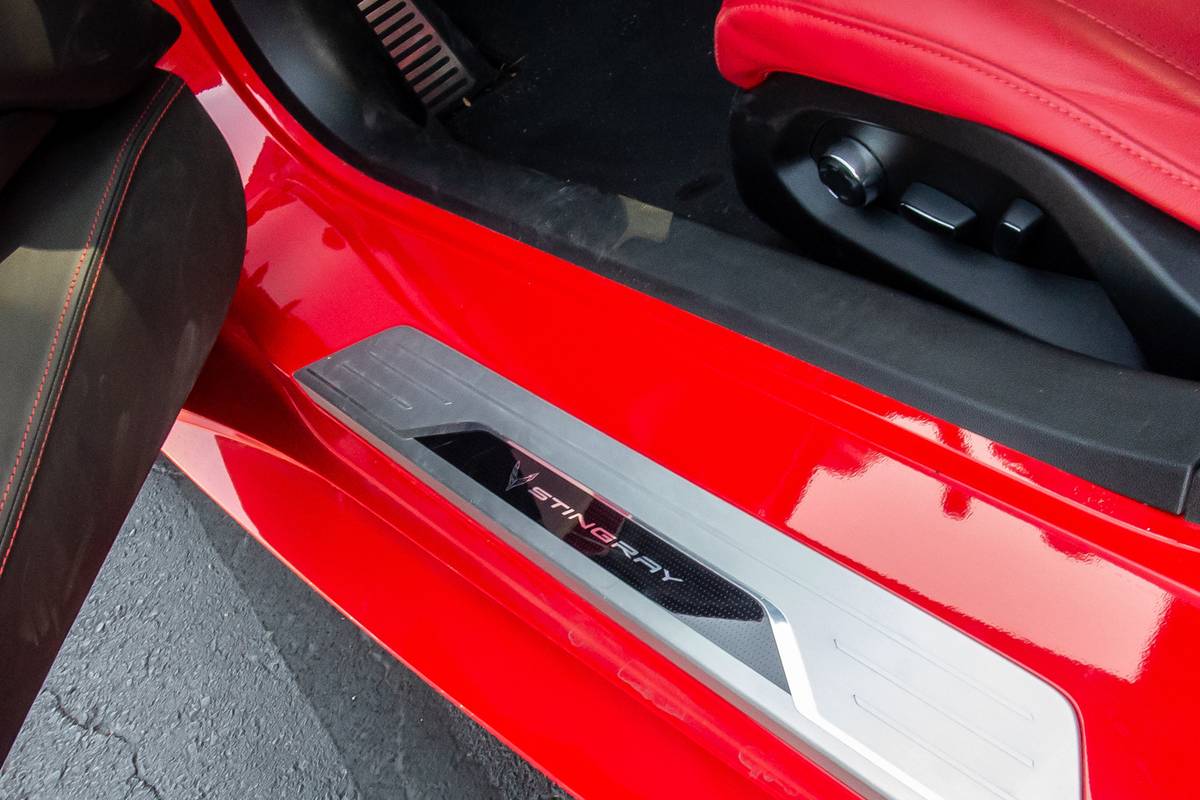
What Chevy didn’t do to get attention, and perhaps should have, is trade the conventional doors for the type that swing up like a wing or scissor. Yes, they’re gimmicky, but they’re a gimmick that sells a lot of cars. On the upside, it was reasonably easy to get in, as the sill isn’t too high or wide. The center console, on the other hand, is even higher than in the 2019 Vette, and where there used to be a grab handle on the passenger side that rose from the console toward the dashboard, a foreboding wall partitions the passenger, topped by a curious single file of ventilation control buttons.
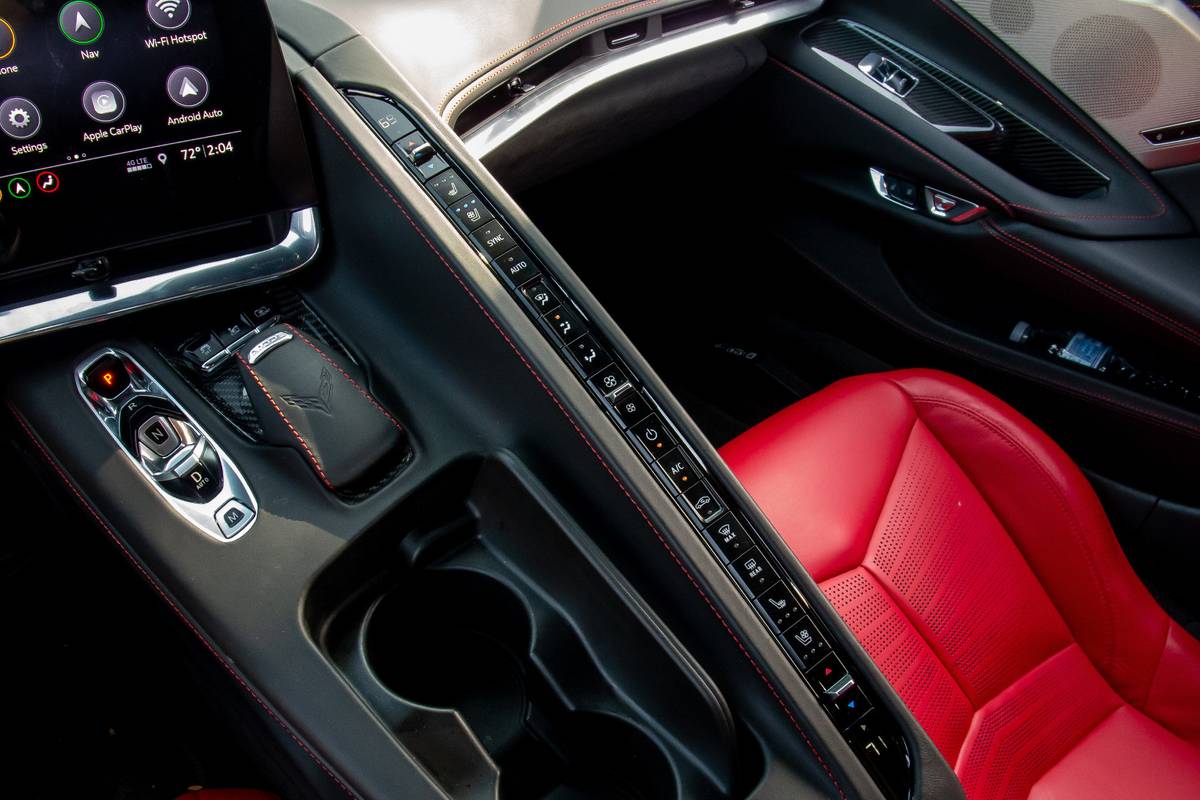
A familiar engine start-stop push button brought the V-8 to life with an equally familiar roar. The only difference is that the sound is now entirely behind you. The Corvette now comes with the LT2 6.2-liter version of the legendary small-block V-8, naturally aspirated, at least for now, and rated at 490 horsepower — or 495 hp with my car’s Z51 Performance Package and its performance exhaust.
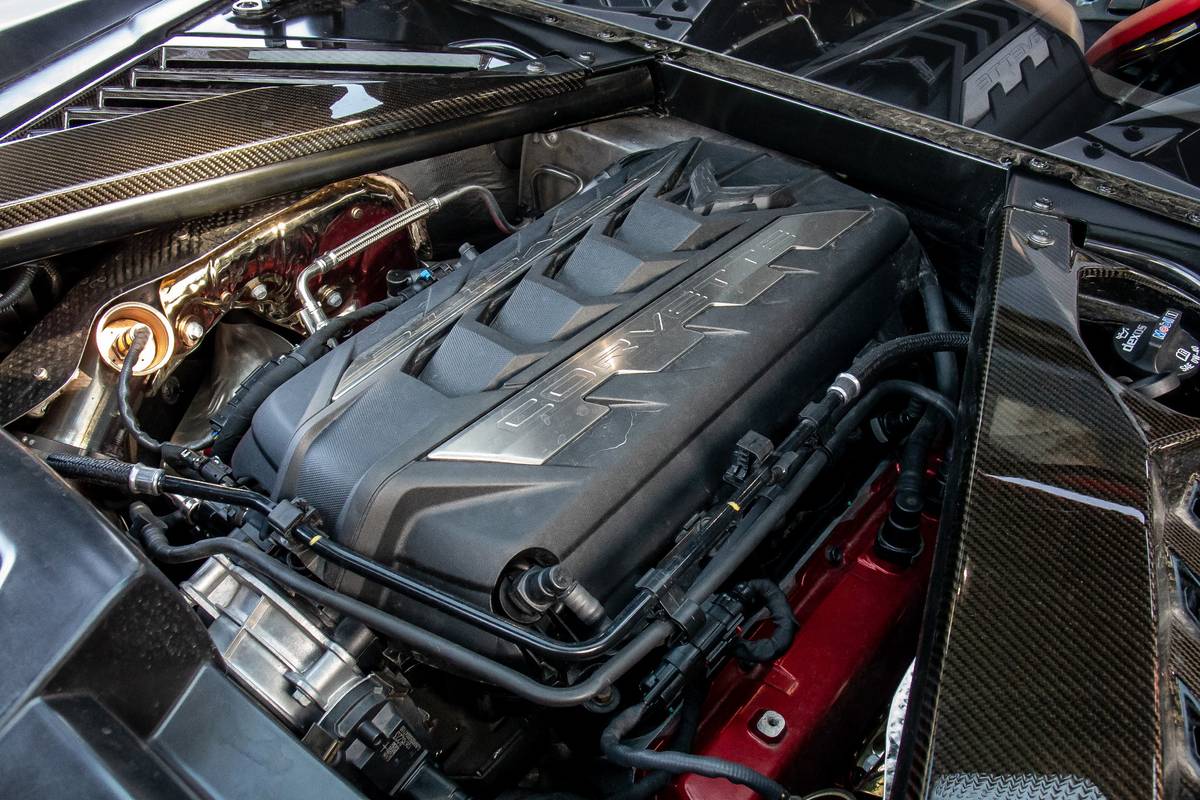
The new eight-speed automatic transmission has push- and pull-button controls, all things that are sure to enrage some purists, but despite their unfamiliar design, I instinctively chose the right motion and put the Vette in drive.
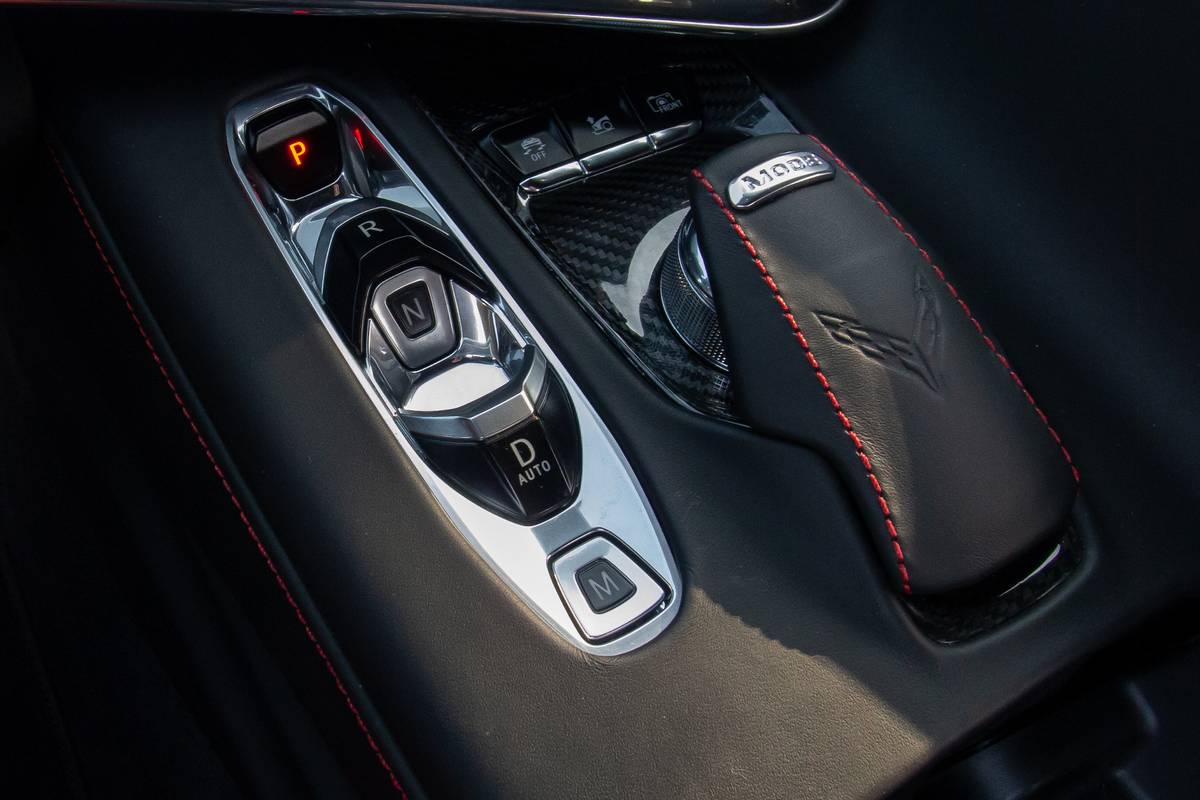
Chevy says the car now does zero-to-60 mph in less than 3 seconds, and that’s definitely how it felt, aided by the Z51 package’s grippy Michelin Pilot Sport 4S summer tires. (All-season tires are standard.) But both Kelsey and I noticed that the engine had to wind out a bit more than expected to get into the power. A development engineer who accompanied me confirmed that the 2020’s engine has a different camshaft that pushes the peak power higher in the rev range. The specs confirm it’s now 6,450 rpm instead of 6,000 for the 2019, despite being more robust. The torque peak, now 470 pounds-feet, has also climbed to 5,150 rpm from 4,600 rpm. Also note that the Z51’s axle ratio is 5.17, which is shorter than the base axle’s 4.89 for higher performance.
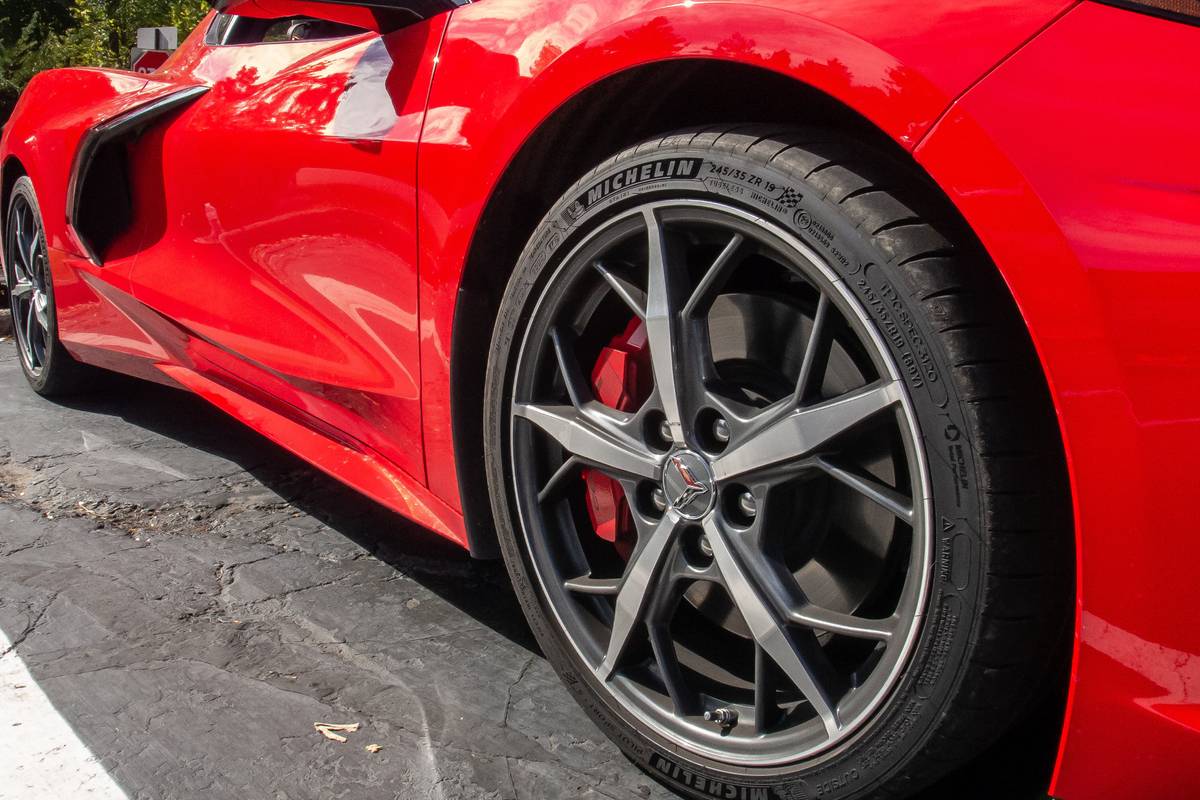
Bearing in mind that this wasn’t an acid test, and that Chevy says these preproduction cars are still being tweaked a bit, the new dual-clutch eight-speed automatic transmission really impressed. I’m not going to say what I’ve heard many times from people discussing other cars that have abandoned three-pedal manual transmissions — that the automatic is so good you won’t even miss the manual. That’s like saying the ice cream is so good you won’t even miss the pizza. Just because they both serve the same bottom-line purpose doesn’t make the experience irrelevant. The loss of the stick is no small matter, and I won’t be letting Chevy off the hook for it under any circumstances.

But it does seem to be a really great gearbox in the vein of Porsche’s revered PDK dual-clutch system. It comes from Tremec, a name long synonymous with high-torque traditional manual transmissions, and the 2020 Vette marks its debut. (A similar Tremec seven-speed is in the new 2019 Ford Shelby GT500, a conventional front-engine design rather than a transaxle.) Upshifts feel instantaneous, and downshifts come without delay. The shift paddles are wired directly to the transmission controller, so there’s no latency. In the more aggressive driving modes like Sport and Track, a quick double or triple click would evoke a jump directly to a low gear rather than stair-stepping down. I kept jabbing at the accelerator pedal under different circumstances, trying to confuse the transmission, but it never took the bait and flaked out. Its reactions always seemed reasonable. According to Tremec, the unit can complete a shift in less than 100 milliseconds, but it clearly shifts slower and smoother in Tour mode than in Track mode for increased comfort.
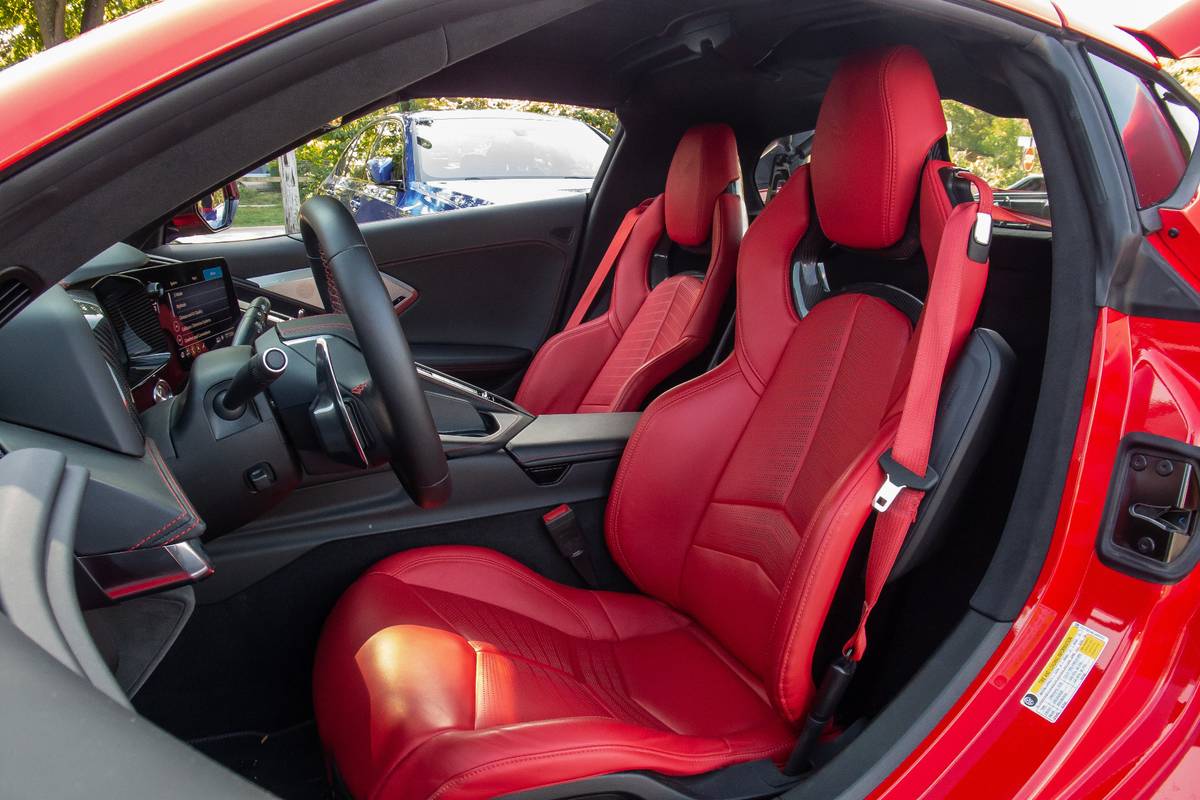
Comfort was one of our big takeaways from the 2020, at least as equipped with the optional Magnetic Selective Ride Control 4.0. The Vette had already evolved into a very comfortable car of its type, especially when compared with the C4 I experienced in high school, but this one reaches new heights. Magnetically variable shock absorbers have been amazing from the beginning, but what makes the difference here is data: Rather than wheel-position sensors alone, the adaptive suspension now receives information from accelerometers on the suspension components and the body itself. You could drive this thing all day in Tour mode, and it’s not bad in Sport, either, especially when going in a straight line.
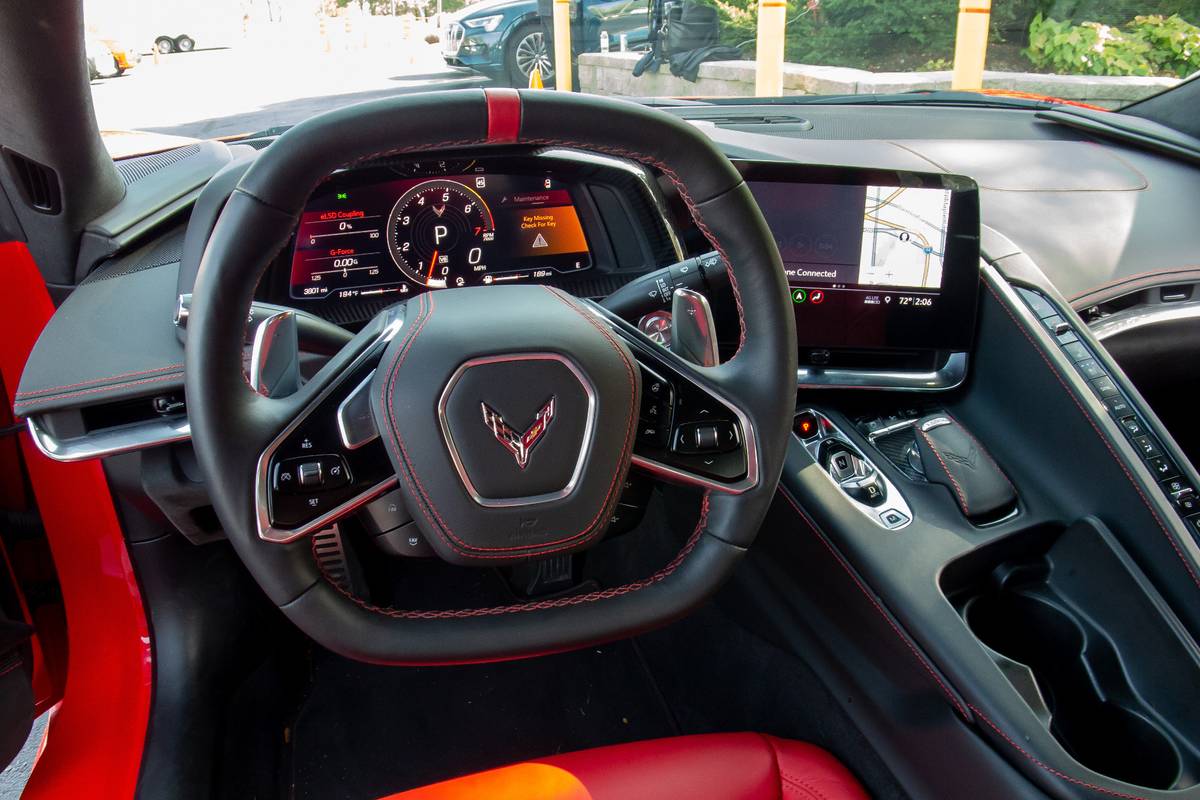
A silver “Z” button on the steering wheel is like BMW’s M and Hyundai’s N buttons — a one-push activation of your personalized settings. Press again, and it defaults to normal. It’s great if the predetermined modes aren’t quite to your liking. They adjust everything you’d expect, like steering assist, throttle, transmission mapping, suspension firmness and active exhaust levels. They also adjust something you might not expect: brake pedal feel …
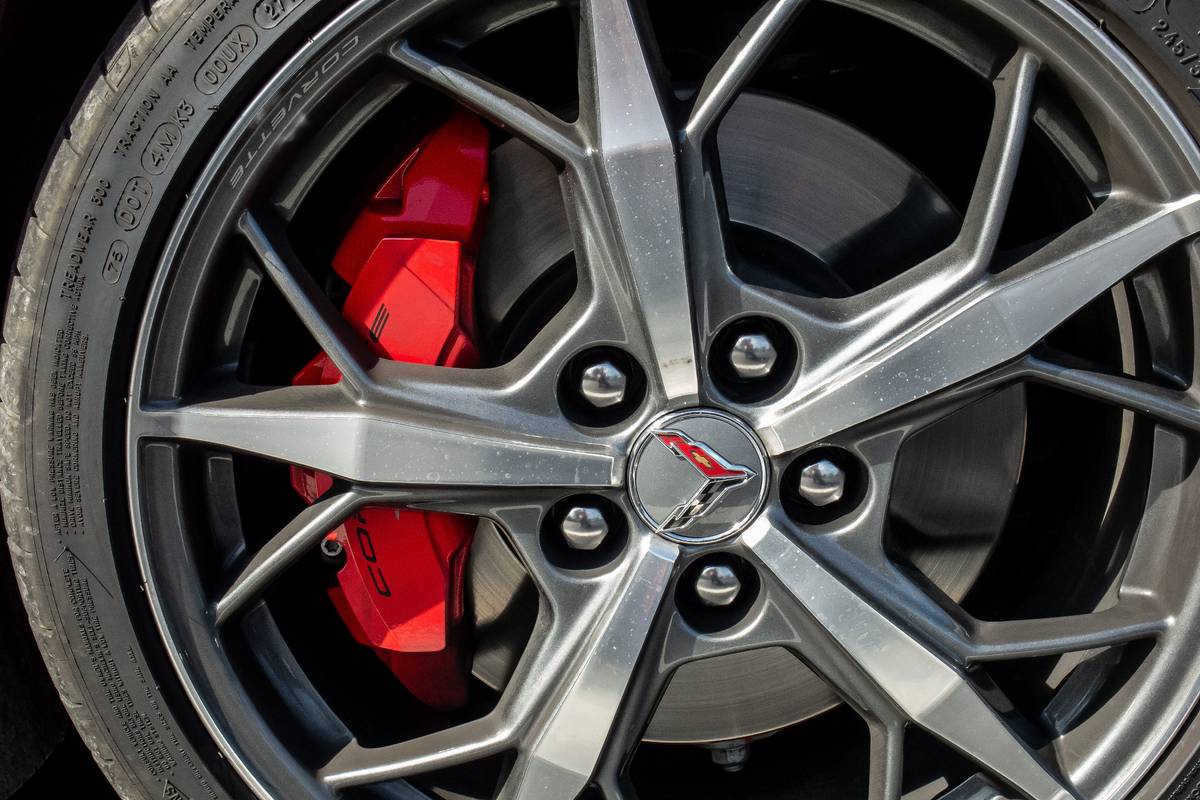
This is the first Corvette with by-wire braking, but by my count the fifth or sixth GM vehicle with it (excluding hybrids and electrics). This technology still uses hydraulic fluid, brake lines and calipers, but it does away with vacuum assist, and the pedal no longer presses directly on a piston in the master cylinder. We’ve had great experiences with this approach (Alfa Romeo Giulia), not so great ones (Cadillac XT4) and a mix in between. Fortunately, in this car, they were good in the street driving I did. (Note that this car combined the standard by-wire system with upgraded Brembo brakes, including larger front and rear discs and monobloc rather than two-piece front calipers.) I’ve definitely experienced better traditional hydraulic brakes, but I’ve also experienced worse, and this system brings a number of advantages, such as stopping power and efficiency. It’s as inevitable in future models as electric power steering recently proved to be, and as likely to exhibit growing pains.
What I wasn’t able to detect during my short drive was a big difference in the pedal feel between modes. I also didn’t get much of a feel for the car’s overall dynamics, because its limits are far beyond what can responsibly be explored on the street. Another advantage of the rear-engine layout should be better weight distribution, which improves lateral grip and changes the car’s rotational axis. The previous generation’s yaw axis was a foot or so in front of the driver, which to me always evoked the image of holding onto a flagpole and being blown about by a gale. The engineers claim the driver is now sitting practically at the car’s yaw center, which could be pretty exciting, and advantageous, on a racetrack. We won’t know until we try.

What I do know is that the view to the rear is awful, as it often is in mid-engine cars. The size and angle of the rear window inhibit vision to begin with, and the fact that you’re looking through two panes doesn’t help. The available camera display that takes over the rearview mirror at the flip of a lever seemed a solution to all problems, until I realized it was too close to focus on. I like full-time rearview cameras, but I’m not as young as I was the first time I reviewed a Corvette for Cars.com, and I can’t always use them without reading glasses — which I obviously don’t wear when driving (reflected mirror images represent distance vision; displays require near vision). Even people who have progressive lenses (and I think you’ll agree that includes a fair number of Corvette owners you’ve witnessed) typically have the near-vision segment at the bottom, not the top, of their spectacles.
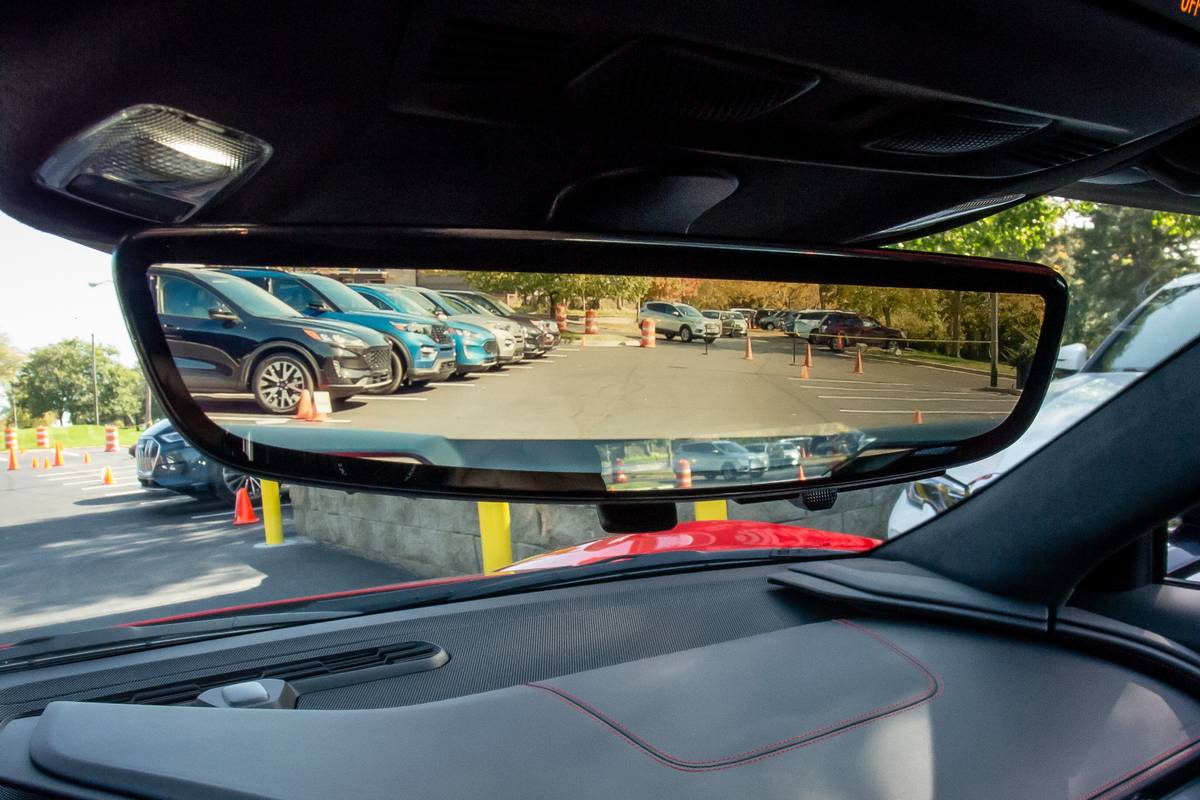
On the flip side, the view to the front is quite good. Getting that pesky engine out of there allowed the hood to drop considerably. The 12-inch digital instrument panel screen is a little busy, and though I don’t like too much drama and animation, I’d prefer if it made driving mode changes more evident. However, I must say they’ve done a nice job of keeping important stuff low on the display where the steering wheel won’t block it even if it’s set low.
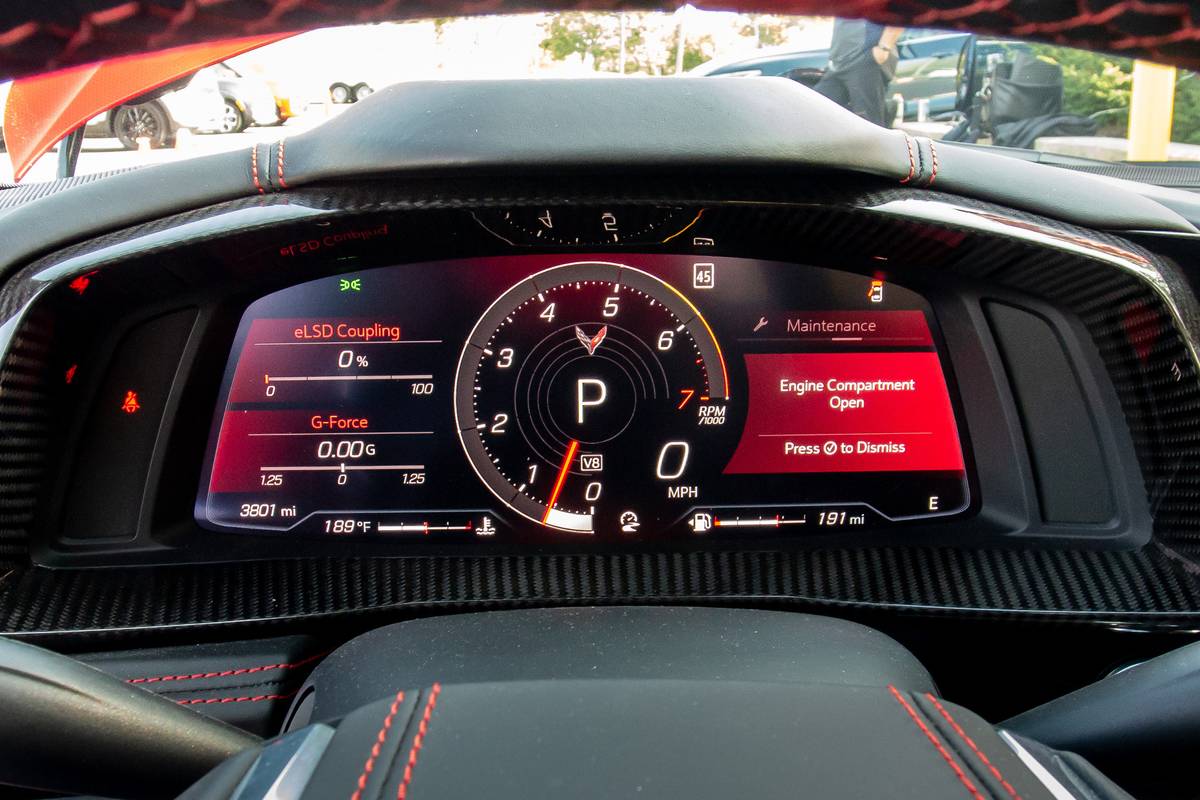
Supplementing the IP, thanks to my car’s optional 3LT Coupe Premium Equipment Package, was a head-up display that blew me away, not because it did more than the best I’ve seen, but because it didn’t seem to dim at all when I put on polarized sunglasses. The Corvette was pretty early to include a HUD that merely dims when viewed this way rather than vanishing entirely, but unless I was crazy from the fumes, this unit was a new milestone. I felt bad raving about it to an engineer who worked so hard on this seemingly world-class racecar only to ride shotgun with some jackass who fixated on the freakin’ display.
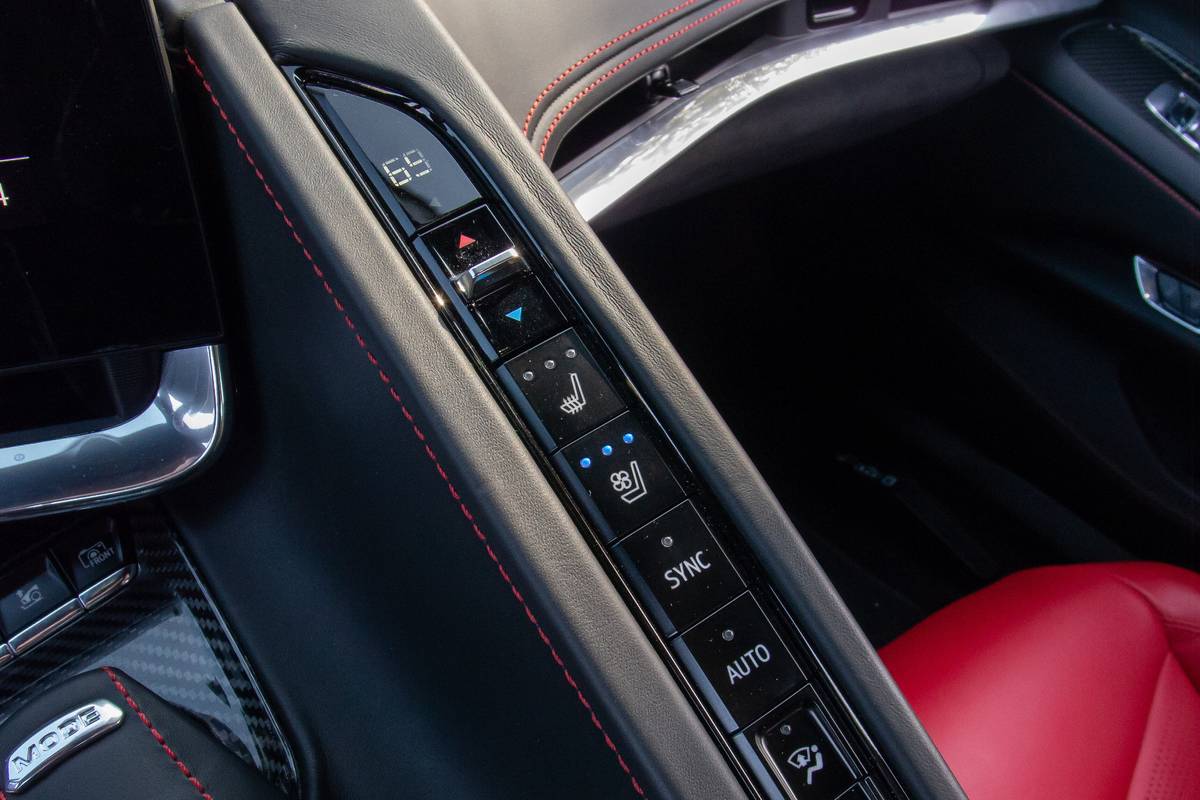
Year after year, the Corvette was hammered for its interior quality, and I don’t know if that will change or not. Given what this car can do for less than $60k, the interior looks fine to me, but it runs with a more expensive group, and that seems to set expectations. The line of ventilation controls is certainly odd, but if you don’t like using them, they are duplicated on the touchscreen. At least some of them are; I didn’t spend too much of my limited time with that (would you?).

Cabin storage options seem to have improved just slightly over the previous generation, and include the optional wireless charging cradle behind the driver’s right elbow, designed to contain a smartphone even during spirited driving.
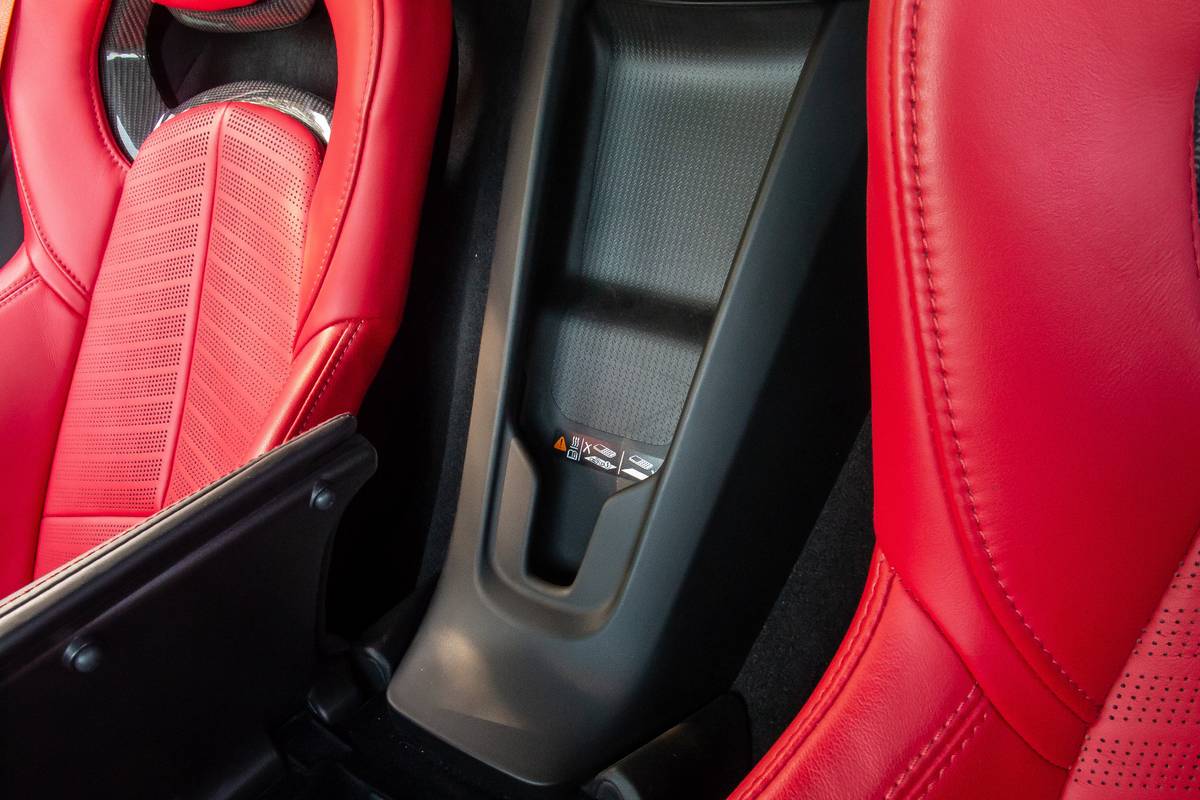
One of the Vette’s great claims to fame has been its generous 15 cubic feet of cargo volume, and though Chevrolet’s spec of 12.6 cubic feet is a downgrade, it’s now divided into separate places, front and rear trunks, which limit the car’s usability further.
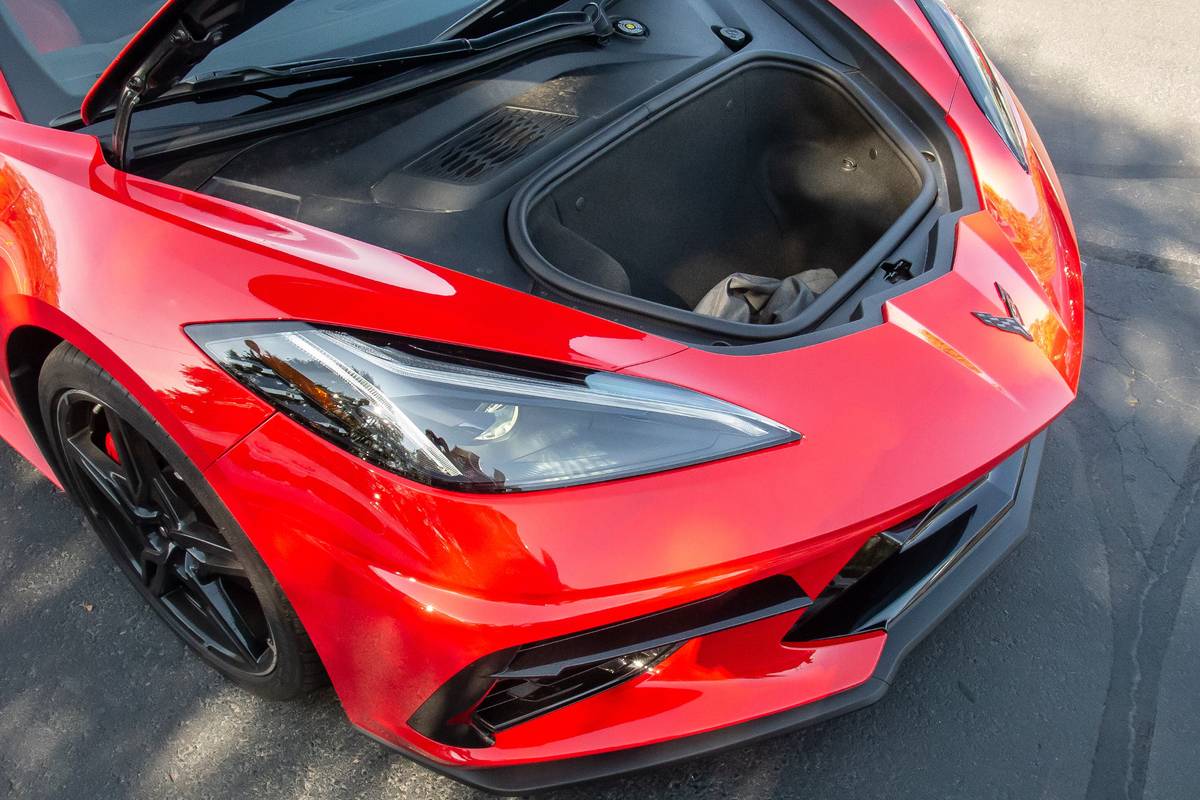
But we suspect few Corvette owners choose it as their only vehicle, and if they have to haul something, there are plenty of other options. If this is the only disadvantage of moving the engine to the rear, it will prove to be a wise step. We look forward to exploring the advantages in the near future.

Editor’s note: This story was updated Nov. 25, 2019, to reflect that the rear camera mirror display is available.
Cars.com’s Editorial department is your source for automotive news and reviews. In line with Cars.com’s long-standing ethics policy, editors and reviewers don’t accept gifts or free trips from automakers. The Editorial department is independent of Cars.com’s advertising, sales and sponsored content departments.

Former Executive Editor Joe Wiesenfelder, a Cars.com launch veteran, led the car evaluation effort. He owns a 1984 Mercedes 300D and a 2002 Mazda Miata SE.
Featured stories

15-Year Car Loans Aren’t a Thing, But Americans Are Getting More Comfortable With Long Loan Terms

2025 Kia Telluride Review: Rougher Roads Ahead



